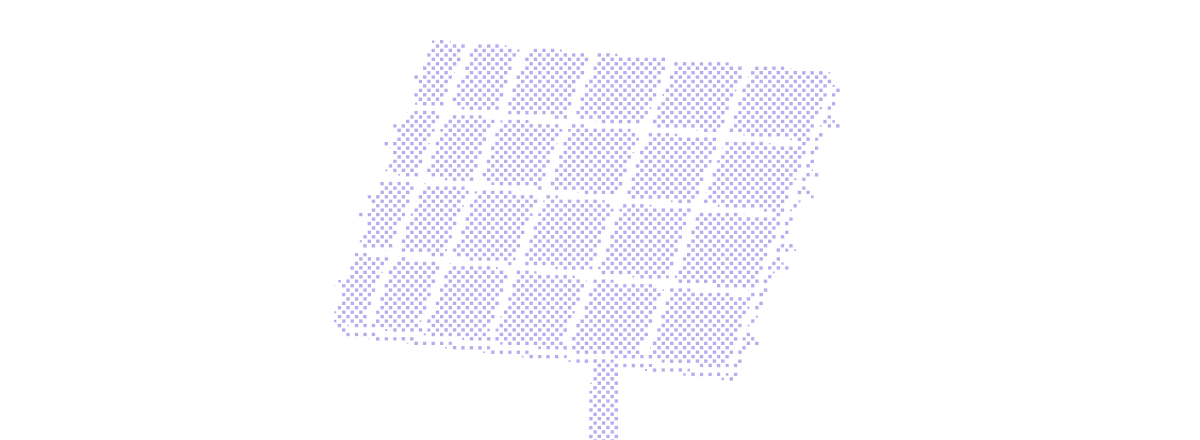Choosing the right ground mount structure: comparing typologies and optimizing project costs
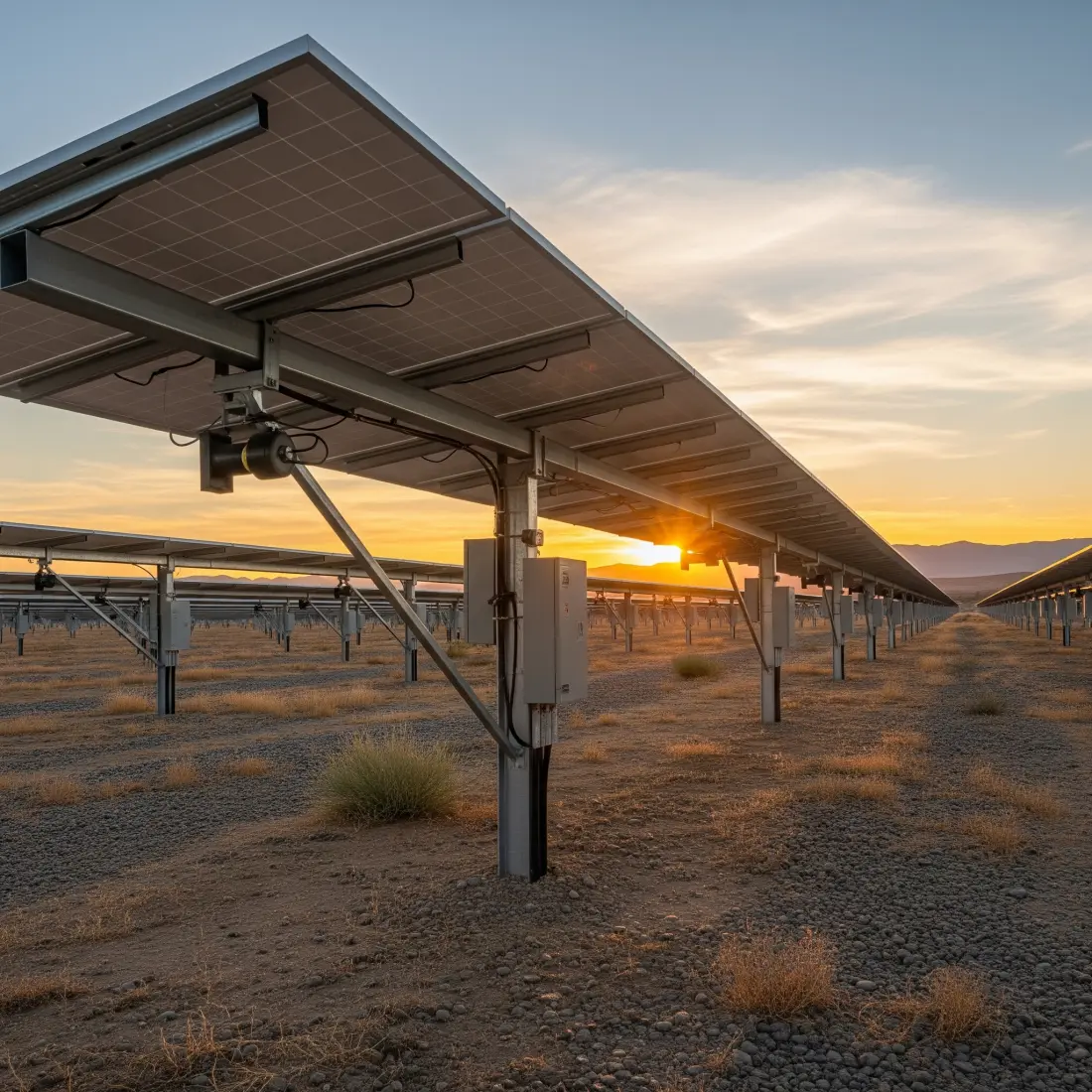

When developing a solar farm, the spotlight often falls on the efficiency of solar modules and the intelligence of inverters. However, the unsung hero of a successful solar project — the ground mount solar rack — plays an equally critical role.
But the choice of this underlying support system goes far beyond simply holding panels in place; it profoundly influences the project's energy yield, directly impacts construction timelines, and significantly shapes the long-term return on investment.
For instance, overlooking the importance of structural selection can lead to unforeseen challenges and missed opportunities. The right choice can maximize energy capture and streamline installation, ultimately contributing to a more profitable and sustainable solar farm. Conversely, an ill-suited ground mount solar rack can introduce costly delays, reduce efficiency, and jeopardize the project's economic viability.
Going through the array of available types of mounting structures presents a significant challenge for developers. The complexity is compounded by the need to balance diverse structural options with stringent cost considerations.
Traditionally, much of this evaluation has relied on manual processes, which are often time-consuming and prone to human error. Today, the industry is moving towards more intelligent design approaches that ensure projects are not only structurally sound but also economically competitive in a rapidly expanding market.
Understanding ground-mounted solar structure typologies: a comparative overview
Choosing the right ground mount structure requires a solid understanding of the different types available and their specific applications. Each typology comes with its own set of advantages, considerations, and ideal use cases, directly affecting a project's overall performance and cost. Let's explore the primary categories of ground mount racking options:
Fixed-tilt
This is the most straightforward and commonly used ground mount structure. Panels are installed at a fixed angle, usually facing south (north in the Southern Hemisphere), to capture sunlight consistently throughout the day.
Advantages:
Lower upfront costs
Simpler to install
Fewer potential points of failure
Long-term reliability
Shorter fixed-tilt frames have better adaptability to the terrain than trackers
Disadvantages:
Less adaptable to seasonal changes in sun path.
Less energy output during the winter months compared to tracking systems.
Considerations:
💡 Best suited for areas with consistent solar radiation.
💡 Fixed-tilt with higher tilt angles can be particularly effective in high-latitude locations like Scandinavia or Canada (or low-latitude like New Zealand or Argentina…) to maximize winter energy capture and shed snow efficiently.
💡 Also excels in regions with abundant, affordable land and minimal shading, where their simplicity and low maintenance make them very competitive.
Cost & O&M:
Fixed-tilt systems serve as our baseline for cost comparisons (1.0x). Their operation and maintenance (O&M) costs are the lowest among all solar rack typologies, as there are minimal moving parts to maintain. This generally means a lower percentage for O&M expenses.
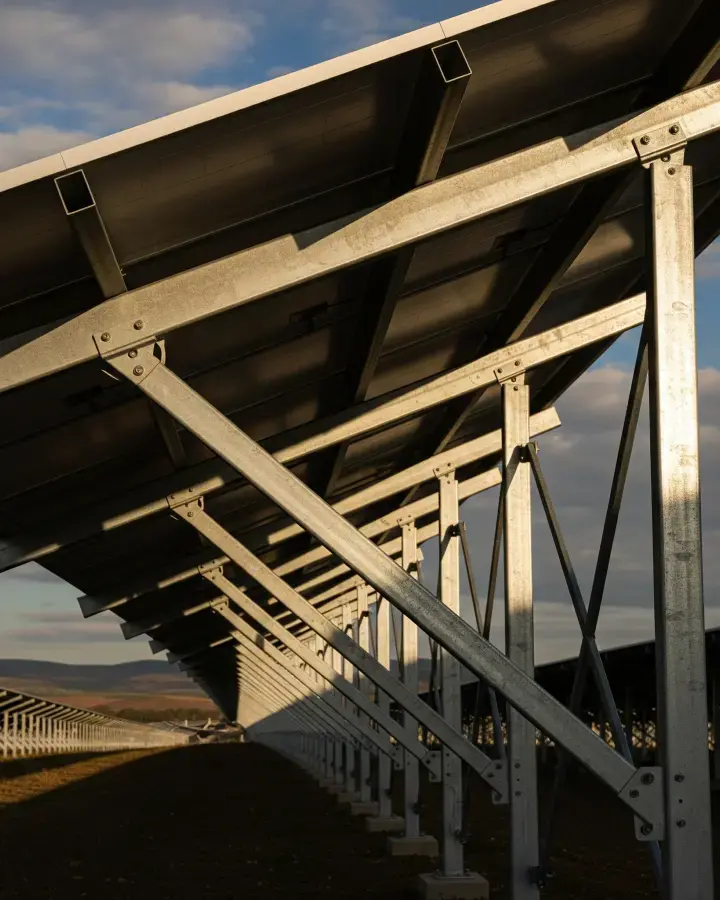
Adjustable-tilt fixed structures
These structures are similar to fixed-tilt systems but allow for manual adjustments of the tilt angle seasonally or periodically.
Advantages:
Improved energy yield compared to purely fixed systems, due to better alignment with the sun's path throughout the year.
Relatively simple design.
Simple to install.
Disadvantages:
The need for manual intervention increases labor requirements for adjustments. Depending on the project's scale and accessibility, this can be a significant O&M factor.
East-West facing
In this fixed-tilt configuration, panels are arranged to face both east and west, often appearing in a "gable" or "sawtooth" design.
Advantages:
Maximized panel density, especially on flat terrains.
Balanced energy production curve throughout the day
Disadvantages:
Slightly lower peak power output compared to optimal south-facing fixed arrays.
Has specific structural requirements to accommodate the dual orientation.
Considerations:
💡Ideal for meeting specific grid demands or managing midday peak production.
Single-Axis Tracker (SAT)
Single-axis trackers follow the sun's path from east to west daily, rotating the panels to maintain an optimal angle.
Advantages:
Significant energy yield increase, typically 15-25%.
Higher capacity factor.
Disadvantages:
Complex system involving motors, controllers, and moving parts.
Higher upfront costs.
Potentially higher maintenance requirements.
Considerations:
💡 Appealing for large-scale utility projects in arid or semi-arid regions with high direct sunlight.
💡 Also very advantageous in areas with high afternoon electricity prices, as they shift production to align with those peak periods.
Cost & O&M: SATs usually cost about 1.1x to 1.3x that of a fixed-tilt system (10-30% more). Their O&M costs are typically 15% to 30% higher than fixed-tilt, due to the need for regular lubrication, inspection of mechanical components, and sensor calibration.
Multi-Row Tracker (often Dual-Row)
Multi-row trackers represent a sophisticated approach to solar tracking. Instead of a single-row tracker, these systems link multiple rows of panels to a single motor. These systems follow the sun's movement both daily (east-west) and seasonally (north-south). While most manufacturers offer dual-row solutions, some provide systems that connect up to ten rows, though this is less common due to terrain challenges.
Advantages:
High energy yield
Reduced levelized cost of energy (by using a single motor to power multiple rows of trackers)
Disadvantages:
Complex and expensive ground mount option.
High maintenance requirements.
Considerations:
💡Ideal for sites with flat, uniform terrain where multi-row configurations can be implemented efficiently without significant grading challenges.
💡Also used in research and development facilities to achieve maximum theoretical yield.
Cost & O&M: Due to their complexity and numerous components, DATs are significantly more expensive than fixed-tilt systems, ranging from 1.5x to 2.5x the cost of a fixed-tilt system (50-150% more). Consequently, their O&M costs can be 40% to 70% higher.
Terrain-Following Trackers
Terrain-following trackers are an evolution of single-axis trackers (SATs) designed to conform to a site's natural topography. Instead of requiring costly land grading, these trackers feature a multi-point articulation system that allows them to follow the land's undulations, opening up previously unsuitable sloped or uneven sites for development.
Advantages:
Reduced civil works and cost
Wider site applicability
Minimal environmental impact
Disadvantages:
Increased structural complexity
Higher initial equipment cost
Considerations:
💡If a site has significant slopes (>5%) or an uneven, undulating surface, terrain-following trackers become a highly attractive option.
💡Ideal for projects in areas with strict grading limitations, erosion control requirements, or sensitive ecosystems.
Cost & O&M: The initial equipment cost for these trackers is typically higher than for traditional SATs (10-20% more), but this is often balanced by a significant reduction in grading expenses (30-50%). While routine O&M is similar, the complex, articulated design means there are more points to inspect. Overall, a detailed Levelized Cost of Energy (LCOE) analysis is crucial to determine if the civil works savings justify the higher equipment and O&M costs.
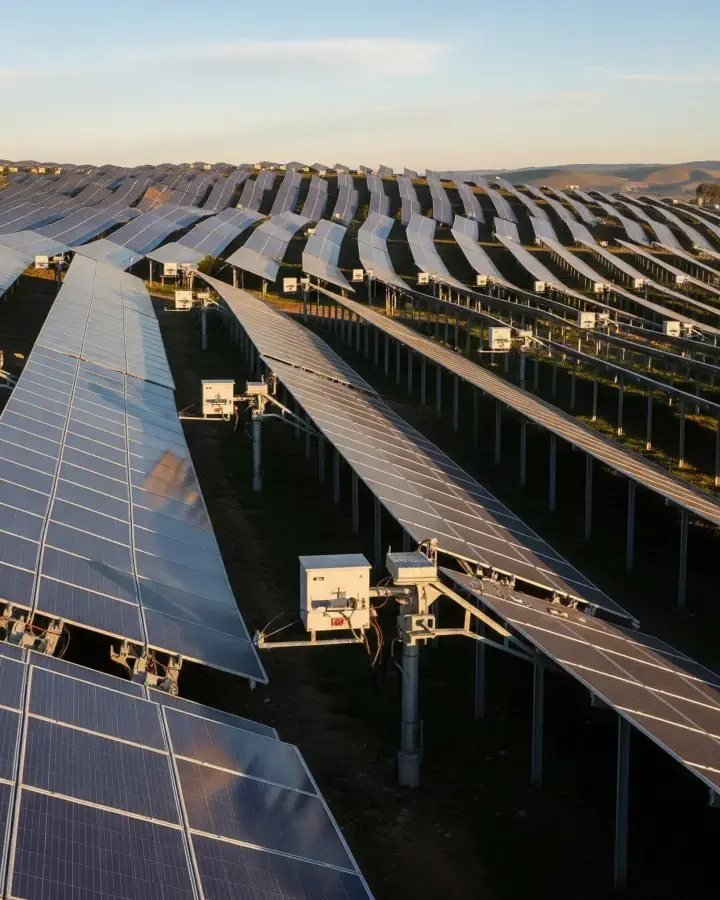
Choosing the right typology for your project: key considerations
Selecting the most suitable ground mount typology isn't a one-size-fits-all decision. It requires a careful evaluation of various elements unique to each project. These elements can be grouped into site-specific factors, project-specific goals, and regulatory or environmental considerations. Each plays a crucial role in determining the optimal ground mount rack for long-term success.
Site-specific factors
The physical characteristics of the project site are fundamental to typology selection.
Topography
Uneven ground might necessitate extensive grading, increasing costs and project timelines. Some structures, like fixed-tilt, are less forgiving on steep slopes, while trackers may require more precise leveling.
Soil conditions
Beyond basic bearing capacity, factors like expansive clays, seismic activity (liquefaction), permafrost, and corrosive soils significantly influence foundation design and, by extension, the most suitable ground mount typology. Each condition necessitates specialized, often costlier, foundations — such as deeper piers, ground improvement, elevated structures, or corrosion-resistant materials.
While any typology can adapt, simpler fixed-tilt or single-axis tracker (SAT) systems often prove more resilient or cost-effective in these challenging environments due to their lower sensitivity to minor ground shifts or a more favorable distribution of increased foundation expenses compared to complex dual-axis trackers.
Solar Resource
The type of solar radiation at your site (Direct Normal Irradiance, DNI, versus Global Horizontal Irradiance, GHI) influences the benefit of tracking. Sites with high DNI often see greater gains from trackers.
Land Availability and Cost
The amount and price of available land dictate density requirements. In areas with limited or expensive land, typologies that maximize power output per acre, such as single-axis or dual-axis trackers, become more attractive.
Project-Specific Goals
Your project's overarching objectives also guide ground mount selection.
📈 Budget constraints: This involves a careful balance between the upfront capital expenditure of the PV structure and the long-term energy yield it enables. A lower initial cost might be appealing, but a slightly more expensive system that significantly increases energy production could offer a better ROI over the project's lifetime.
📈 Energy production targets: Maximizing kilowatt-hour (kWh) output is often a primary goal. If the aim is to achieve the highest possible energy generation, tracking systems are generally preferred despite their higher complexity.
📈 Grid interconnection requirements: The local grid might have specific needs regarding power delivery. Some grids prefer flatter production curves to avoid midday peaks, which might favor east-west or fixed-tilt arrays. Others might be able to accommodate the higher, more concentrated output of tracking systems.
📈 Operations & maintenance (O&M) considerations: The complexity and accessibility of the chosen structure type directly impact O&M costs and procedures.
Regulatory and Environmental Considerations
External regulations and environmental sensitivities can impose strict limitations or dictate specific design approaches for ground mount solar racking.
Local regulations often specify requirements for structure height, setbacks, and overall project type.
Minimizing ground disturbance and considering local ecological impacts are increasingly important. This includes protecting specific flora and fauna, managing stormwater runoff, and addressing visual aesthetics.
By carefully evaluating these site-specific, project-specific, and regulatory factors, developers can make an informed decision on the ideal ground mount typology, ensuring the long-term success and profitability of their solar farm project.
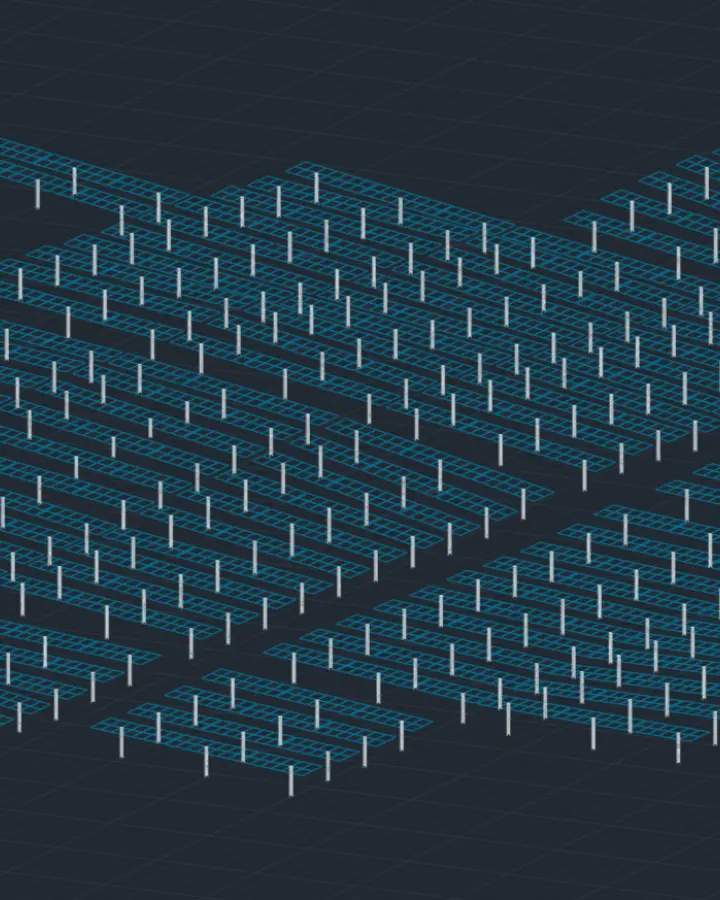
Optimizing project costs through intelligent design
Translating the ideal choice of typology into a truly cost-optimized reality demands more than traditional methods. Rigorously testing and refining different structures and layouts directly impacts spending and overall project economics.
This is precisely where intelligent design platforms become indispensable, offering specific features that equip engineers and developers with tools to improve their designs and control costs effectively. Some of these are:
✅ Flexible capacity planning and iteration: A robust platform should allow easy testing of different system sizes and configurations, providing instant insights into yield implications for ROI calculations. Such agility enables rapid iteration through various ground mount structures (fixed-tilt, trackers, etc.), offering quick comparisons of how structural choices impact potential power output within given areas.
✅ Terrain-adaptive layout design: Mapping module tables to real-world terrain ensures optimal land use and higher energy capture, while minimizing grading — a significant cost factor. This capability helps developers evaluate how effectively different typologies (like fixed-tilt or trackers) adapt to complex terrain.
✅ Improved shading limit calculations: Intelligent design platforms utilize advanced algorithms to precisely calculate shading limits, even on varied terrain, by accounting for elevation differences. Such precision enables better utilization of buildable area and allows for packing more DC capacity while respecting shading limits. The result is a more realistic comparison of how various typologies perform under different shading scenarios, guiding the selection of the most efficient structure.
✅ Collision analysis: Early identification of potential construction barriers, such as boulders or buried utilities, prevents costly surprises and installation delays. Such a feature helps refine layouts by confirming the chosen solar module structure’s constructibility on the specific site, avoiding expensive re-designs or unforeseen issues during construction.
✅ Detailed civil analysis (slope analysis, ground grading, cross-section): Comprehensive civil analysis tools are essential for assessing terrain gradients, identifying risk zones, and strategically planning necessary land alterations. Insights into the site's structural capabilities enable better designs that minimize earthwork costs. Furthermore, this allows developers to choose a typology best suited to civil constraints.
✅ Integrated electrical design & cabling: Generating, visualizing, and optimizing cabling paths translates into minimized voltage drops and reduced total cable length, saving material and labor costs. Advanced functionalities, like detailed cable specifications and voltage drop results, alongside separate configuration of DC main and DC string cabling, enable more realistic cost estimation and installation planning. Beyond that, integrated electrical features allow for comparing electrical infrastructure costs across different typologies.
✅ Seamless data integration with feasibility and performance tools: The ability to transfer data quickly and accurately between early-stage feasibility tools and detailed design platforms is fundamental. A streamlined workflow allows for rapid iteration of designs based on initial site assessments, enabling developers to test various typologies against real-world constraints efficiently. Subsequent integration with performance modeling tools can provide accurate yield data needed to compare financial metrics like LCOE and IRR, ultimately dictating the optimal structural choice and optimizing project costs.
Ultimately, intelligent design software transforms the solar development process by ensuring that initial typology choices translate into cost-effective and high-performing projects. These capabilities are paramount for dealing with complex terrain and budget considerations. PVcase Ground Mount encompasses all these features, providing a complete solution for optimizing your solar farm designs.
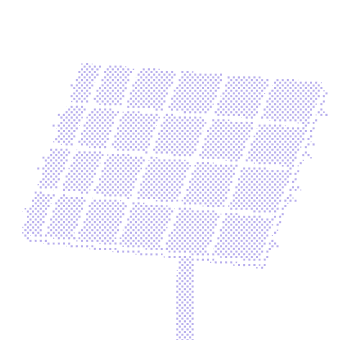

Leverage latest and greatest solutions to maximize your ROI
Book a demo and learn how to navigate PVcase's site selection and PV design solutions to maximize your return on investment.

